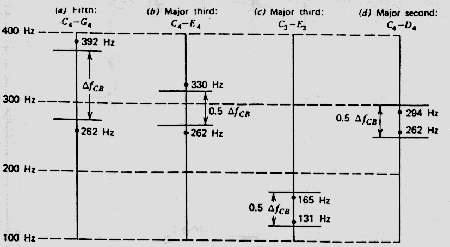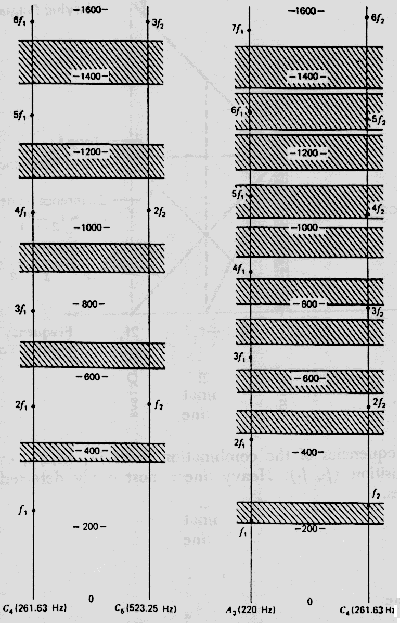The Critical Band Theory of Plomp
With a series of experiments on consonance and dissonance judgment, Plomp has
concluded that two pure tone frequencies falling outside the critical band (![]() fCB) are judged
as being consonant.
fCB) are judged
as being consonant.
These experiments revealed that the most dissonant interval is the one for which the two pure tone frequencies are separated by 25% of the critical band. In fact frequencies differing in the range 5 to 50% of their critical band are typically judged dissonant.
Therefore we are led to conclude that two pure tones whose frequency difference is less than 50% of the appropriate critical bandwidth for those frequencies is a dissonance.
In the following examples we will examine a perfect fifth, two major thirds and a major second.

Example 1: The fifth C = 262 Hz to G = 392 Hz (assuming the tempered scale) has
a centre frequency (i.e. average frequency) of 327 Hz. The critical bandwidth ![]() fCB at 327 Hz is,
from the table, 100 Hz. This means that any two tones within the range 277 to 377
Hz will have the described harsh, rough quality. The frequencies 262 and 392 do not
fall within this range, and so the interval is judged consonant.
fCB at 327 Hz is,
from the table, 100 Hz. This means that any two tones within the range 277 to 377
Hz will have the described harsh, rough quality. The frequencies 262 and 392 do not
fall within this range, and so the interval is judged consonant.
Example 2: For the major third C = 262 Hz to E = 330 Hz, the centre frequency
is 296 Hz for which ![]() fCB
= 95 Hz. This interval is considered consonant since the frequency difference of
the two pure tones is greater than 0.5
fCB
= 95 Hz. This interval is considered consonant since the frequency difference of
the two pure tones is greater than 0.5 ![]() fCB.
fCB.
Example 3: For the major third C = 131 Hz to E = 165 Hz, one octave lower than
that in example 2 above, the centre frequency is 148 Hz for which ![]() fCB = 90 Hz. This interval is certainly
less consonant in terms of the Plomp criterion than that in example 2, and may even
be considered a dissonant interval.
fCB = 90 Hz. This interval is certainly
less consonant in terms of the Plomp criterion than that in example 2, and may even
be considered a dissonant interval.
Example 4: For the major second C = 262 Hz to D = 294 Hz, the centre frequency
is 278 Hz for which ![]() fCB
= 95 Hz. It is according to the Plomp criterion a dissonance.
fCB
= 95 Hz. It is according to the Plomp criterion a dissonance.
The experimental results obtained for pure tones are extended to complex tones.
Each complex tone in a musical interval has a 'family' of harmonics. If harmonics
up to 6ffund are considered for each complex tone, consonances will have a predominance
of neighbouring harmonics whose frequency difference is greater than 0.5 ![]() fCB. A dissonance, on the other
hand, will have neighbouring harmonics whose frequency difference is less than 0.5
fCB. A dissonance, on the other
hand, will have neighbouring harmonics whose frequency difference is less than 0.5
![]() fCB.
fCB.
